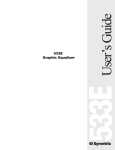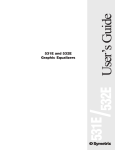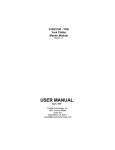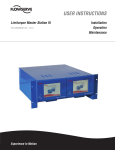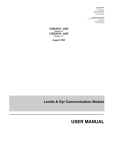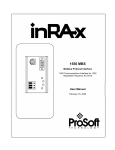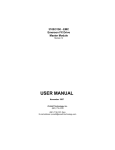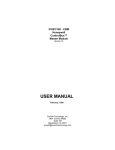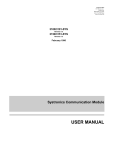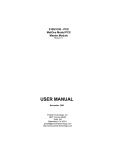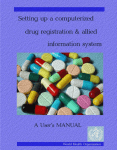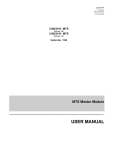Download 3100/3150-LTQ User Manual
Transcript
3100/3150 – LTQ Limitorque Valve Actuator Master Module Revision 1.7 Allen-Bradley PLC 5 w/ ProSoft 3100-LTQ (SLC support available w / ProSoft 3150-LTQ) Limitorque RS-232/485 Isolators/Converters Loop Mode Network of Limitorque Valve Actuators Supports up to 150 valve actuators Redundant communications Each device is an active repeater on the network Looped connections to the LTQ module allows a single line break or short while maintaining communications to all actuators USER MANUAL February 2000 ProSoft Technology, Inc. 1675 Chester Ave., Fourth Floor Bakersfield, CA 93301 [email protected] Please Read This Notice Successful application of the LTQ card requires a reasonable working knowledge of the Allen-Bradley PLC or SLC hardware and the application in which the combination is to be used. For this reason, it is important that those responsible for implementing the LTQ satisfy them selves that the combination will meet the needs of the application without exposing personnel or equipment to unsafe or inappropriate working conditions. This manual is provided to assist the user. Every attempt has been made to assure that the information provided is accurate and a true reflection of the product's installation requirements. In order to assure a complete understanding of the operation of the product, the user should read all applicable Allen-Bradley documentation on the operation of the A-B hardware. Under no conditions will ProSoft Technology, Inc. be responsible or liable for indirect or consequential damages resulting from the use or application of the LTQ product. Reproduction of the contents of this manual, in whole or in part, without written permission from ProSoft Technology, Inc. is prohibited. Information in this manual is subject to change without notice and does not represent a commitment on the part of ProSoft Technology, Inc. Improvements and/or changes in this manual or the product may be made at any time. These changes will be made periodically to correct technical inaccuracies or typographical errors. Copyright 1996, 1997, 1998, 2000 ProSoft Technology Inc. Product Revision History 09/23/96 Revision 1.0 Initial release of product 04/30/97 Corrected manual errors 01/31/00 Add Accutronix MX documentation 02/23/00 Added Special Polling documentation i Implementation Guide Integration of the LTQ module into a PLC or SLC application is easier the first time if a series of steps are followed. In order to assist the first time users of our products in getting the LTQ operational quickly, we have come up with this step-by-step implementation guide. a) Obtain project application and operation requirements. Read and understand all relevant specifications drawings, diagrams, checkout procedures, performance audits, etc. b) Read the 3100/3150-LTQ User Manual. c) Obtain and read appropriate Limitorque supporting documents for product being networked. These documents may be obtained from your local Limitorque representative or downloaded from the Limitorque website: http://www.limitorque.com 435-23009 130-43510 440-20014 435-20013 437-13001 130-11000 DDC-100 Direct-to-Host Programming Guide Accutronix MX DDC-100 Field Unit Installation and Operation Manual DDC-100 UEC Field Unit (Modbus) Installation and Operation Manual DDC-100 I/O Module Installation and Operation Manual DDC-100 UEC Field Unit (UEC-3-DDC) Wiring & Startup Guidelines Accutronix MX Installation & Operation Manual d) Starting with one of the ladder logic programs provided on disk with the LTQ, complete the following steps: PLC 5 LTQ5 SLC 5/03 LTQ503 e) Edit the ladder logic provided on disk as needed for the application Verify rack and slot location in program Modify ladder instruction addresses as needed Reference Appendix for tips in the SLC platform f) Setup the Communication Configuration parameters (See Section 2) Determine the configuration requirements Baud Rate, Slave Count, and the Active Slave Map g) Identify the jumper requirements (See Appendix) h) Make up the communication cables (See Section 5) i) Place processor into the run mode j) Monitor the data table Error Status values (See Section 2) ii Table of Contents Revision History Implementation Guide i ii 1 Product Specifications................................................................................................................................................. 1 2 LTQ Theoretical Operation ......................................................................................................................................... 2 2.1 Block Transferring Data to the Module ............................................................................................................. 2 2.1.1 Communications Configuration [ BTW Block ID 255 ]........................................................................... 3 2.1.2 Command Blocks [ BTW Block ID Code 0 to 5 ]..................................................................................... 7 2.2 Transferring data from the module [ BTR Block ID 0 to 30 ].......................................................................10 2.2.1 The Read Data Block Structure................................................................................................................11 2.2.2 Moving the data from the module to the processor..............................................................................11 2.2.3 Slave Data Results.....................................................................................................................................12 2.2.4 Command Done Bits .................................................................................................................................16 2.2.5 Module Information Table .........................................................................................................................15 3 Protocol Commands .................................................................................................................................................16 4 Diagnostics and Troubleshooting ..........................................................................................................................17 4.1 3100 PLC Platform LED Indicators .................................................................................................................19 4.2 3150 SLC Platform LED Indicators .................................................................................................................20 4.3 Troubleshooting - General................................................................................................................................21 4.4 Communication Error Codes ...........................................................................................................................22 5 Cable Connection ......................................................................................................................................................21 Appendix Support, Service and Warranty Jumper Configurations SLC Programming Considerations Limitorque Network Polling Scheme Programming Recommendations Example Ladder Logic PLC-5 SLC-5/03 1 Product Specifications The 3100/3150-LTQ (“Limitorque Valve Master Module”) product family allows Allen-Bradley 1771 and 1746 I/O compatible processors to easily interface as a host with up to 150 Limitorque Valve actuators. The LTQ product includes the following standard features: General Specifications • Support for up to 150 Limitorque valve actuators Supports all models, including: MX/DDC-100 UEC-3-DDC Modbus DDC-100M I/O Module DDC-100M Field Unit Valvcon IVO (unit is multidrop only) • Implements Limitorque’s Port A/B polling scheme using both ports on the LTQ module • RS-232 or RS-485 communications (jumper selectable) • Software configuration (From processor ladder logic) Baud Rate: 1,200 to 38,400 Message Response Timeout Number of active slaves: 1 to 150 Last State on Comm Fail Network Polling Scheme Looped Port 1 Only Port 2 Only Active Slave Table: Bit mapped • Supported commands: Continuously Polled Read registers 40008 – 40013, Optional: 40055 or 40006/40007 Commands Open Stop Close Initiate Network ESD Terminate Network ESD Engage Contactors 1 - 6 Disengage Contactors 1 - 6 Position Valve (0 - 100%) • Data returned to the ladder data table includes the following per valve: Valve Position (0 – 100%) Status Register Fault Register Digital Outputs Digital Input Registers 1 and 2 Comm Error Code Comm Counter Special Polled Registers • Response time The protocol drivers are written in Assembly and in a compiled higher level language. As such, the interrupt capabilities of the hardware are fully utilized to minimize delays, and to optimize the product's performance Hardware Specifications • Backplane Current Load: 3100 3150 • • • Operating Temperature Storage Temperature Connections: 3100 3150 : 0.65 A : 0.15 A at 5 V 0.04 A at 24 V : 0 to 60 C (32 to 140 F) : -40 to 85 C (-40 to 185 F) : 2 - DB25 Female Connectors : 2 - DB9 Male Connectors 1 2 LTQ Theoretical Operation Data transfers between the processor and the ProSoft Technology module occur using the Block Transfer commands, in the case of the PLC, and M0/M1 data transfer commands, in the case of the SLC. These commands transfer up to 64 physical registers per transfer. The logical data length changes depending on the data transfer function. The following discussion details the data structures used to transfer the different types of data between the ProSoft Technology module and the processor. The term 'Block Transfer' is used generically in the following discussion to depict the transfer of data blocks between the processor and the ProSoft Technology module. Although a true Block Transfer function does not exist in the SLC, we have implemented a pseudo-block transfer command in order to assure data integrity at the block level. Examples of the PLC and SLC ladder logic are included in Appendix A. In order for the ProSoft Technology module to function, the PLC must be in the RUN mode, or in the REM RUN mode. If in any other mode (Fault/PGM), the block transfers between the PLC and the module will stop, and communications will halt until block transfers resume. 2.1 Block Transferring Data to the Module Data transfer to the module from the processor is executed through the Block Transfer Write function. The different types of data which are transferred require slightly different data block structures, but the basic data structure is: Word 0 Name BTW Block ID 1 to 63 Data BTW Block ID Description A block page identifier code. This code is used by the ProSoft module to determine what to do with the data block. Valid codes are: BTW Code Description 0 Open/Stop/Close/ESD Commands 1 Engage/Disengage 1 - 3 Commands 2 Engage/Disengage 4 - 6 Commands 3-5 Valve Position Commands 255 Module Communication Configuration The data to be written to the module. The structure of the data is dependent on the Block ID code. The following sections provide details on the different structures. PLC Memory 0 Open/Stop/Close etc. Cmds 1 Engage/Disengage Contactors 1-3 2 Engage/Disengage Contactors 4-6 3 Valve Position Cmd (1-48) 4 Valve Position Cmd (49-96) 5 Valve Position Cmd (97-150) 255 Configuration Data 2 BTW Command Word 0 1 2 3 4 : : : 63 BTW Block ID Although the full physical 64 words of the data buffer may not be used, the BTW and M0 lengths must be configured for 64 words otherwise module operation will be unpredictable. 2.1.1 Communications Configuration [ BTW Block ID 255 ] The ProSoft Technology firmware communication parameters must be configured at least once when the card is first powered up, and any time thereafter when the parameters must be changed. On power up, the module enters into a logical loop waiting to receive configuration data from the processor. While waiting, the module sets the second word of the BTR buffer to 255, telling the processor that the module must be configured before anything else will be done. The module will continuously perform block transfers until the communications configuration parameters block is received. Upon receipt, the module will begin execution of the command list if present, or begin looking for the command list from the processor. Transferring the Communications Configuration Parameters to the module will force a reset of the communication ports The configuration data block structure which must be transferred from the processor to the module is as follows: BTW Block ID 255 Word 0 1-10 11-20 BTW Buffer 0 Data Word Description BTW Block ID = 255 Config parameters Active Slave Table Description Block ID Header = 255 Configuration Parameters 1 N[ ]:0 Baud Rate 2 N[ ]:1 Response Timeout 3 N[ ]:2 Max Number of Slaves 4 N[ ]:3 Read Block Count 5 N[ ]:4 Block Transfer Delay Count 6 N[ ]:5 Last State on Comm Fail 7 N[ ]:6 Network Poll Scheme 8 N[ ]:7 Propagation Delay 9 N[ ]:8 RTS to TxD Delay 10 N[ ]:9 Polling (special) Active Slave Table 11-20 N[ ]:10-19 Slaves 1 - 150 Configuration Memory map for Example Application Baud Rate 0 Read Block Count Slave Count Response Timeout 1 2 3 BT Delay Count Last State 4 5 6 Polling Scheme Propagation Delay Polling (Special) RTS to TxD 7 8 9 N7:0 7 200 16 0 0 0 0 0 0 0 Configuration Parm N7:10 1 1 0 0 0 0 0 0 0 0 Active Slave Table 3 Name Description Baud Rate The baud rate at which the port is to operate. The available configurations are as follows: Value Baud Rate 2 1200 Baud 3 2400 Baud 4 4800 Baud 5 9600 Baud * 6 19200 Baud 7 38400 Baud * Limitorque Field Unit Factory Default Setting Message Response Timeout This register represents the message response timeout period in 1 msec increments. This is the time which a port configured as a Master will wait before re-transmitting a command if no response is received from the addressed slave. The value is set depending on the expected slave response times. A value of 200 msec should be the minimal setting. Values from 200 to 65535 (0xffff) are permitted. Max Number of Slaves This value is used by the module to optimize the number of data blocks returned to the PLC data table as well as several of the internal logic routines. The value entered here can range from 1 to 150, and should always meet or exceed the last slave in the Active Slave Table. Read Data Block Count This value represents the number of 50 word data blocks which are to be transferred from the LTQ Module to the processor. The blocks returned from the module start at block 0 and increment from there. The maximum block count is 80. As an example, a value of 5 will return BTR Block ID data blocks 0, 1, 2, 3, and 4, or module registers 0 to 249. If a value of 0 is entered the LTQ module uses the Number of Slaves configuration value to determine the Read Block Count value. Block Transfer Delay Counter This is an empirical value used by the module to balance the amount of time the module spends block transferring and the amount spent handling port communications. The value entered is used as a loop counter in the module, where each time through the loop the count is incremented. When the count equals the Block Transfer Delay Counter a Block Transfer sequence is initiated. Example: In Master Mode applications with the module in a remote rack, the frequency of command execution can be improved by entering a value of 75-150. The value must be determined empirically. Last State on Comm Fail This value determines the state of the Limitorque read register values which are returned to the PLC upon the detection of a communication failure state (ie., comm has failed on both Port A and B). Value Description 0 Clear last data values (default) 1 Maintain last data values 4 Network Polling Scheme Value Description 0 Loop Mode (Port 1 and 2 alternating) 1 Port 1 polling only 2 Port 2 polling only The Network Loop Mode emulates Limitorque’s polling scheme which takes advantage of the actuator ability to repeat data transmissions and to operate in a looped mode. In this mode, the module will alternate communications between Port 1 and 2. Command failures on one port will be retried on the other port. Active Slave Table These 10 words allow the user to configure the specific slaves which are active on a network. The intent of this table is to allow the user to selectively enable slave addresses and therefore not have to be concerned about activating slave addresses continuously. Active Slave Table Word 0 15 Bits 0 1000 0000 0000 0001 Slave Address #1 Enable Slave Address #16 Enable All values are entered into the table in a right to left order with bit 0 representing the lower address. The slave addresses are mapped into the table as follows: Word Description 0 Slaves 1 to 16 1 Slaves 17 to 32 2 Slaves 33 to 48 3 Slaves 49 to 64 4 Slaves 65 to 80 5 Slaves 81 to 96 6 Slaves 97 to 112 7 Slaves 113 to 128 8 Slaves 129 to 144 9 Slaves 145 to 150 Propagation Delay Provides a delay time between primary port polls to prevent network collisions on port changeover. Values should be no lower than the listed minimal settings. The value represents delay time in milliseconds. Value Number of Slaves 0 1 to 20 10 21 to 40 15 41 to 60 20 61 to 80 25 81 to 100 30 101 to 120 35 121 to 140 40 141 to 150 Note: These values are reference only. Empirical data gathered on site will enable proper adjustment of these values. Slave #1 Channel A Fail bit (port 1) being true AND all other slave communications not in fault will be an indication of improper adjustment of this value. 5 RTS to TxD Polling (Special) This value represents the time in 1 msec increments for delay between asserting RTS and the actual transmission of data. Delay between the receipt of messages and transmit of new message must be greater than 10 msec. When used, a value of 20 is typically inserted into this field. Note: This value is reference only. Empirical data gathered on site will enable proper adjustment of these values. Enables polling of specific registers in addition to the standard polling. A value other than zero will cause an additional poll request to be sent to the slaves that are enabled. The results are placed in registers 8 and 9 in the slave response data block. Using this feature has a performance cost as the time available for the standard polling is shared with the special polling. Value Description 0 Disabled 1 Register 55, TP_BEFORE_MID_T_HIGH 2 Registers 6/7, Analog Input 1 and 2 6 2.1.2 Command Blocks [ BTW Block ID Code 0 to 5 ] An LTQ Master port establishes communications and performs various communications functions based on data the user has placed in the Command Blocks. The Command Blocks are 60 word data blocks containing bit mapped ‘Enable Bits’. The actual command executed by the module is determined by the user setting the correct ‘Enable Bit’ to a 1. All commands are one-shoted by the module (ie., the module must see a 1 to 0 transition before the command can be re-enabled with a 0 to 1 transition). The user may use the ‘Cmd Done Bit’ (See Section 2.2.4) to clear the command or any other means appropriate. This command data, entered into the processor Data Table, is transferred to the module's memory using Block IDs 0 through 5, depending on the command to be executed. Word 0 1 to 10 11 to 20 21 to 30 31 to 40 41 to 50 51 to 60 Description BTW Block ID Code ( = 0 ) Open Commands - Slaves 1-150 Stop Commands - Slaves 1-150 Close Commands - Slaves 1-150 Initiate ESD - Slaves 1-150 Terminate ESD - Slaves 1-150 Spare (Future) Word 0 1 to 10 11 to 20 21 to 30 31 to 40 41 to 50 51 to 60 Description BTW Block ID Code ( = 1 ) Engage Contactor #1 - Slaves 1-150 Disengage Contactor #1 - Slaves 1-150 Engage Contactor #2 - Slaves 1-150 Disengage Contactor #2- Slaves 1-150 Engage Contactor #3 - Slaves 1-150 Disengage Contactor #3 - Slaves 1-150 Word 0 1 to 10 11 to 20 21 to 30 31 to 40 41 to 50 51 to 60 Description BTW Block ID Code ( = 2 ) Engage Contactor #4 - Slaves 1-150 Disengage Contactor #4 - Slaves 1-150 Engage Contactor #5 - Slaves 1-150 Disengage Contactor #5- Slaves 1-150 Engage Contactor #6 - Slaves 1-150 Disengage Contactor #6 - Slaves 1-150 Word 0 1 to 3 6 to 53 Description BTW Block ID Code ( = 3 ) Analog Write Enable - Slaves 1 to 48 Analog Values - Slaves 1 to 48 Word 0 1 to 3 6 to 53 Description BTW Block ID Code ( = 4 ) Analog Write Enable - Slaves 49 to 96 Analog Values - Slaves 49 to 96 Word 0 1 to 4 6 to 59 Description BTW Block ID Code ( = 5 ) Analog Write Enable - Slaves 97 to 150 Analog Values - Slaves 97 to 150 7 Command Blocks Block ID 0 16 Slave Address 1 0000 0000 0000 0001 32-17 Slave 16-1 0 Bit mapped Commands (Ex. Send Open Command to slave #1) 64-49 1 48-33 2 96-81 3 80-65 4 5 127-113 150-144 112-97 143-128 6 7 8 9 N10:0 1 0 0 0 0 0 0 0 0 0 Open Commands N10:10 0 0 0 0 0 0 0 0 0 0 Stop Commands N10:20 0 0 0 0 0 0 0 0 0 0 Close Commands N10:30 0 0 0 0 0 0 0 0 0 0 Init Net ESD Commands N10:40 0 0 0 0 0 0 0 0 0 0 Stop Net ESD Commands N10:50 0 0 0 0 0 0 0 0 0 0 Spare Block ID 1 N10:60 1 0 0 0 0 0 0 0 0 0 Engage Contactor #1 N10:70 0 0 0 0 0 0 0 0 0 0 Disengage Contactor #1 N10:80 0 0 0 0 0 0 0 0 0 0 Engage Contactor #2 N10:90 0 0 0 0 0 0 0 0 0 0 Disengage Contactor #2 N10:100 0 0 0 0 0 0 0 0 0 0 Enagage Contactor #3 N10:110 0 0 0 0 0 0 0 0 0 0 Disengage Contactor #3 Block ID 2 N10:120 1 0 0 0 0 0 0 0 0 0 Engage Contactor #4 N10:130 0 0 0 0 0 0 0 0 0 0 Disengage Contactor #4 N10:140 0 0 0 0 0 0 0 0 0 0 Engage Contactor #5 N10:150 0 0 0 0 0 0 0 0 0 0 Disengage Contactor #5 N10:160 0 0 0 0 0 0 0 0 0 0 Engage Contactor #6 N10:170 0 0 0 0 0 0 0 0 0 0 Disengage Contactor #6 8 Block ID 3 16 Slave Address 1 Bit mapped Commands 0000 0000 0000 0001 (Ex. Send Open Command to slave #1) 32-17 Slave 16-1 0 Valve Position Cmd Enables 1 48-33 2 3 4 5 6 7 8 9 N11:0 1 0 0 0 0 75 0 0 0 0 N11:10 0 0 0 0 0 0 0 0 0 0 N11:20 0 0 0 0 0 0 0 0 0 0 N11:30 0 0 0 0 0 0 0 0 0 0 N11:40 0 0 0 0 0 0 0 0 0 0 N11:50 0 0 0 0 0 0 0 0 0 0 Valve Position Values ( 0 to 100 %) Block ID 4 80-65 Slave 64-49 0 Valve Position Cmd Enables 1 96-81 2 3 4 5 6 7 8 9 N11:60 1 0 0 0 0 30 0 0 0 0 N11:70 0 0 0 0 0 0 0 0 0 0 N11:80 0 0 0 0 0 0 0 0 0 0 N11:90 0 0 0 0 0 0 0 0 0 0 N11:100 0 0 0 0 0 0 0 0 0 0 N11:110 0 0 0 0 0 0 0 0 0 0 Valve Position Values ( 0 to 100 %) Block ID 5 128-113 150-145 Valve Position Cmd Enables Slave 112-97 144-129 0 1 2 3 4 5 6 7 8 9 N11:120 1 0 0 0 0 75 0 0 0 0 N11:130 0 0 0 0 0 0 0 0 0 0 N11:140 0 0 0 0 0 0 0 0 0 0 N11:150 0 0 0 0 0 0 0 0 0 0 N11:160 0 0 0 0 0 0 0 0 0 0 N11:170 0 0 0 0 0 0 0 0 0 0 9 Valve Position Values ( 0 to 100 %) Command Usage for Limitorque Products LTQ Commands Open Stop Close Start Network ESD Stop Network ESD Engage Relay #1 Engage Relay #2 Engage Relay #3 Engage Relay #4 Engage Relay #5 Engage Relay #6 Disengage Relay #1 Disengage Relay #2 Disengage Relay #3 Disengage Relay #4 Disengage Relay #5 Disengage Relay #6 2.2 MX-DDC Yes Yes Yes Yes Yes Yes (AS-1) Yes (AS-2) Yes (AS-3) Yes (AS-4) Yes (AR-1) Yes (AR-2) Yes (AS-1) Yes (AS-2) Yes (AS-3) Yes (AS-4) Yes (AR-1) Yes (AR-2) UEC-3-DDC Yes Yes Yes Yes Yes Do Not Use Do Not Use Yes (K3) Do Not Use Do Not Use Yes (K6) Do Not Use Do Not Use Yes (K3) Do Not Use Do Not Use Yes (K6) I/O Module Do Not Use Do Not Use Do Not Use Do Not Use Do Not Use Yes (K2) Yes (K1) Yes (K3) Yes (K4) Yes (K5) Yes (K6) Yes (K2) Yes (K1) Yes (K3) Yes (K4) Yes (K5) Yes (K6) Transferring data from the module [ BTR Block ID 0 to 30 ] When the LTQ Master port driver reads data from a slave the resulting data is placed into the ProSoft module’s data space (Addresses 0 to 1499). The structure of each set of slave data is predetermined and programmed into the module (see below). The position of each slave’s data structure is a function of the slave address, with the data table beginning at slave 1 and working upwards. The transfer of data from the ProSoft Technology module to the processor is executed through the Block Transfer Read function. The following sections detail the handling of the read data. Although the full physical 64 words of the data buffer may not be used, the BTR and M1 lengths must be configured for a length of 64 words, otherwise module operation will be unpredictable The ladder logic must be programmed to look at the BTR buffer, decode several words, and then take action. 10 2.2.1 The Read Data Block Structure The BTR buffer definition is: Word 0 Name BTR Block ID Description The ladder logic uses this value to determine the contents of the data portion of the BTR buffer. With some conditional testing in ladder logic, the data from the module can be placed into the PLC/SLC data table. The relationship between the BTR Block ID number and the register table can be put into an equation: Starting Register Address = Block ID Number * 50 Valid codes are between 0 and 79. 1 BTW Block ID The module returns this value to the processor to be used to enable the movement of and command data blocks to the module. BTR Buffer Word 0 1 2 3 4 : : : 63 2 to 51 (50 words) 52 to 61 (10 words) 2.2.2 Data Command Done Bits BTR Block ID BTW Block ID BTW Buffer Word 0 BTW Block ID 1 2 3 4 : : : 63 The contents of the module’s Register Data space (0 3999). The data will contain the slave data structure for up to 5 slaves. The structure is outlined below. These 10 words contain bit mapped Command Done Bits which correspond to the slave address (i.e., bit 0 of the block corresponds to slave #1, etc.). These bits are intended to be used to unlatch the Cmd Enable bits through ladder logic. Moving the data from the module to the processor Data which has been read from the slave devices is deposited into a 4000 word register table in the module based on the slaves Modbus address. The data register table is transferred from the module to the ladder logic through a paging mechanism designed to overcome the 64 physical word limit of the BTR instruction. The paging mechanism is outlined in the discussion above, but the important thing to understand is the relationship between the page numbers (BTR Block ID numbers) and the register addresses in the module. The diagram also shows the layout for an example application. Note the number of blocks returned from the module to the ladder logic is d etermined by the value entered in the module’s configuration ‘Max Number of Slaves’ register, or if non-zero, the value in ‘Read Block Count’. In this example we have assumed a ‘Max Slave Count’ value of 15, allowing three (3) data blocks to be returned from the module. 11 LTQ Module Memory PLC Data Memory PLC Data Addr N12:0 Read Data Block Block ID 0 to 79 Address : 0 to 3999 Slave Structure #1 Slave Structure #2 Slave Structure #3 Slave Structure #4 Slave Structure #5 N12:50 0 49 50 N12:100 99 100 N12:150 149 150 N12:200 199 200 N12:250 249 250 Block ID 0 Block ID 1 Block ID 2 Read Data from Slaves to PLC These data blocks being returned to the PLC will contain the slave data in pre-formatted structures. Each block will contain 50 words, with each slave consuming 10 words. Each block returns data for 5 slaves. Block ID 3 Block ID 4 Block ID 14 1499 Read Data Blocks being returned from the LTQ module to the PLC data table. The actual number of data blocks returned from the module is determined by the value ‘Max Number of Slaves’ entered during module configuration (1 block is returned per 5 slaves). 2.2.3 Slave Data Results The data values returned from each of the active slaves are placed in the module’s data table and then transferred over to the PLC data table for handling by the ladder logic. Several important points to understand include: 1. 2. 3. 4. The position of each slave’s data in the module is determined solely by the Slave Address The positioning of data in the module begins with Slave Address 1 and goes to Slave Address 150 (Max number supported by the LTQ module) Each slave address, whether activated in the Active Slave Table or not, has space reserved in the module Non-contiguous slaves in the Active Slave Table will result in holes in the data table being returned from the module. Although not normally a problem, caution should be exercised when selecting slave addresses to minimize these holes (ie., reduce the number of Block Transfers needed to read back the data). The structure of the BTR buffer when reading data from the module is as follows: Word 0 1 2 to 11 12 to 21 22 to 31 32 to 41 42 to 51 Description BTR Block ID Code BTW Block ID Slave #1 Response Slave #2 Response Slave #3 Response Slave #4 Response Slave #5 Response 12 Command Response Block (Example Logic) Fault Status Register Valve Digital Register Position Outputs 0 1 2 3 Digital Polling Digital Inputs 1 Inputs 2 Comm (Special) Comm Counter Polling Status (Special) 4 5 6 7 8 9 N12:0 0 2 0 0 33 0 0 320 0 0 Slave #1 Response N12:10 50 68 0 0 0 0 0 320 0 0 N12:20 100 1 0 0 9 0 0 320 0 0 Slave #3 Response N12:30 0 3200 0 0 0 0 8 0 0 0 Slave #4 Response N12:40 0 3200 0 0 0 0 8 0 0 0 Slave #5 Response Slave #2 Response Slave data after placement into the PLC data table. Slave #x Response: The structure of each slaves read data and communication status data is as follows: Position 0 1 2 Name MX-DDC UEC-3-DDC Analog Register Status Register Bit 00 01 02 03 04 05 06 07 08 09 10 11 12 13 14 15 Fault Register Bit 00 01 02 03 04 05 06 07 08 09 10 11 12 13 14 15 Valve Position (0 – 100%) Valve Position (0 – 100%) Opened Closed Stopped Opening Closing Valve Jammed Local Mode Selected Combined Fault * Thermal Overload Fault Future Use Channel A Fault Channel B Fault Open Torque Switch Fault Close Torque Switch Fault Manual Operation Phase Error Opened Closed Stopped Opening Closing Valve Jammed Local Mode Selected Combined Fault * Thermal Overload Fault Fail De-Energize Channel A Fault Channel B Fault Open Torque Switch Fault Close Torque Switch Fault Manual Operation Phase Error Not Used Not Used Not Used Not Used Phases Missing Phase Reversed Not Used Not Used Not Used Not Used Network ESD is ON ** Local ESD is ON Unit Reset since last poll Local Stop Selected Opening in Local Closing in Local Open Verify Fault Close Verify Fault Open De-Energize Fault Close De-Energize Fault Phases Missing Phase Reversed Manual Mid to Open Manual Open to Mid Manual Mid to Close Manual Close to Mid Network ESD is ON** Local ESD is ON Unit Reset since last poll Wrong Rotation Opening in Local Closing in Local * Combined Fault: Bit 07 of Field Unit Status Register (Word 1) indicates a fault when both bits 10 AND 11, or bit 05, or 08, or 09, or 15 indicate a fault. ** Field unit Network ESD Parameter must be configured to Open, Stop, or Close. 13 Position 3 4 5 6 Name Digital Output Bit 00 01 02 03 04 05 06 07 08 09 10 - 15 Digital Inputs 1 Bit 00 01 02 03 04 05 06 07 08 09 10 11 12 13 14 15 Digital Inputs 2 Bit 00 01 02 03 04 05 06 07 08 09 10 11 12 13 14 15 Communication Status Code 7 Communication Counter 8 Polling (Special) 0 1 2 Polling (Special) 0 1 2 9 MX-DDC UEC-3-DDC Close Contactor Open Contactor AS-1 AS-2 AS-3 AS-4 AR-1, Opt AR-2, Opt AR-3, Opt Network Relay Not Used Close Contactor Open Contactor User (K3) SW-93 LED SW-93 LED User (K6) N/A N/A Bits 08 - 15 Field Unit Software Version ID Remote Mode Selected Thermal Overload Fault Open Torque Switch Open Limit Switch Close Torque Switch Close Limit Switch Not Used Not Used User 0, Terminal-21 User 1, Terminal-10 User 2, Terminal-9 User 3, Terminal-6 User 4, Terminal-7 User 5, Terminal-5 User 6, Opt, Terminal-23 User 7, Opt, Terminal-24 Remote Mode Selected Thermal Overload Fault Open Torque Switch Open Limit Switch Close Torque Switch Close Limit Switch Aux. Open Input Aux. Close Input User 0, TB2-1 User 1, TB2-2 User 2, TB2-3 User 3, TB2-4 User 4, TB2-5 User 5, TB2-6 User 6, I/O Module Only User 7, I/O Module Only Not Used Analog In 1 Lost Not Used Analog In 2 Lost Analog In 1 Lost Analog In 3 Lost Analog In 2 Lost Analog In 4 Lost Network A/B Lost Network A/B Lost Not Used Reserved DDC Bd. Present Reserved I/O Opt Board Present Reserved Not Used Reserved Not Used Reserved Not Used Reserved Not Used Reserved Phase Lost Phase Lost Phase Reverse Phase Reverse User 8, Opt, Terminal-25 User 8, I/O Module Only Not Used User 9, I/O Module Only See Trouble Shooting Section. Do not use this word to determine Slave communication status. Word N[ ]:1 (Status) bits 10 and 11 are preferred. This is a module diagnostic word only. This is a rollover counter (0 to 32767) which increments upon completion of every successful communication transaction with a slave. This counter will increment on poll (read) commands as well as write commands. Unused TP_BEFORE_MID_T_HIGH Register 55 Analog 1 Register 6 Unused Unused Analog 2 Register 7 14 For a more complete discussion on register values for Limitorque actuators or I/O Modules, please reference Limitorque Document #435-23009, available from Limitorque. 15 2.2.4 Command Done Bits The LTQ Module returns ‘Command Done’ bits to the ladder logic. A single bit is returned per slave address, allowing ladder logic to be used to clear the Command Enable bits. The following important points should be noted about the Command Done bits: 1. 2. 3. There is only one bit returned per slave address, not one bit per command per slave. The implication of this is that one Done bit must be used to clear all possible Enable bits for one slave address. Example logic is provided in the Appendix demonstrating this The Command Done bit is a positive indication that the module executed the command. It is not an indication of the command’s success. A Done bit is returned to the ladder logic whether the command was completed without error or not. This allows all commands to be unlatched the same way. To determ ine if there is a communication problem with a slave, verify the Channel A/B Comm Status bits in the slave Status field. The Done bit data registers in the module are cleared and then updated prior to each backplane transfer sequence. This is done to assure that the ladder logic receives the quickest possible acknowledgment of a commands execution. The structure of the Command Done bits in the BTR buffer when reading data from the module is as follows: Word 52 53 54 55 56 57 58 59 60 61 Description Cmd Done - Slaves 1 - 16 Cmd Done - Slaves 17 - 32 Cmd Done - Slaves 33 - 48 Cmd Done - Slaves 49 - 64 Cmd Done - Slaves 65 - 80 Cmd Done - Slaves 81 - 96 Cmd Done - Slaves 97 - 112 Cmd Done - Slaves 113 - 128 Cmd Done - Slaves 129 - 144 Cmd Done - Slaves 145 - 150 16 2.2.5 Module Information Table The LTQ Module provides product data to the ladder logic during power up through the BTR data buffer whenever the BTW Block ID is set to 255. This data is useful for determining revision information and can b e useful should support be necessary from the factory. This 10 word block of data is returned in the BTR data fields. Word 0 1 2-3 4-5 6-7 8-9 10-11 Description BTR Block ID Code BTW Block ID( =255 ) Product Name (ASCII) Revision (ASCII) Operating System Rev(ASCII) Production Run Number (ASCII) Spare Product Name: These two words represent the product name of the module in an ASCII representation. In the case of the LTQ product, the letters ‘ LTQ ‘ should be displayed when placing the programming software in the ASCII data representation mode. Revision: These two words represent the product revision level of the firmware in an ASCII representation. An example of the data displayed would be ‘1.01’ when placing the programming softw are in the ASCII data representation mode. Operating System Revision: These two words represent the module’s internal operating system revision level in an ASCII representation. Production Run Number: This number represents the ‘batch’ number that your particular chip belongs to in an ASCII representation. Revision Module Type N7:30 Operating System Batch Number 0 1 2 3 4 5 6 7 8 9 LT Q 1. 00 09 0 0 0 0 0 17 Module Info 3 Protocol Commands The ProSoft Technology LTQ module Master module is pre-programmed to support a subset of the Modbus protocol. The commands are hard coded into the module and have been selected to implement specific functionality. The programmed commands are documented in the following table. For a more complete discussion on these commands for Limitorque actuators or I/O Modules, please reference Limitorque Document #435-23009, available from Limitorque. Command Function Modbus Function Code 3 Register Address Open Command 6 40001 Stop Command Close Command 6 6 40001 40001 Start Network ESD 6 40001 Stop Network ESD 6 40001 Engage Relay #1 6 40001 Engage Relay #2 6 40001 Engage Relay #3 6 40001 Engage Relay #4 6 40001 Engage Relay #5 6 40001 Engage Relay #6 6 40001 Disengage Relay #1 6 40001 Disengage Relay #2 6 40001 Disengage Relay #3 6 40001 Disengage Relay #4 6 40001 Disengage Relay #5 6 40001 Disengage Relay #6 6 40001 Send Valve Position Value Enable Valve Position Value Poll Slave Special 1 6 40002 6 40001 3 40055 1 Poll Slave Special 2 3 40006 2 Poll Slave 40008 Count or Write Value 6 Description Command is executed automatically to any slave in the Active Slave Table 256 Open Command (Interlocked with Close Command in the slave) 512 Disengages Open or Close 768 Close Command (Interlocked with Open Command in the slave) 1280 Initiates Network ESD function in the addressed slave 1536 Terminates Network ESD function in the addressed slave 2304 Engages Relay #2 (I/O Module) Engages AS-1 (MX-DDC) 2560 Engages Relay #1 (I/O Module) Engages AS-2 (MX-DDC) 2816 Engages Relay #3 Engages AS-3 (MX-DDC) 3072 Engages Relay #4 (I/O Module) Engages AS-4 (MX-DDC) 3328 Engages Relay #5 (I/O Module) Engages AR-1 (MX-DDC) 3584 Engages Relay #6 Engages AR-2 (MX-DDC) 4352 Disengages Relay #2 (I/O Module) Disengages AS -1 (MX-DDC) 4608 Disengages Relay #1 (I/O Module) Disengages AS -2 (MX-DDC) 4864 Disengages Relay #3 Disengages AS -3 (MX-DDC) 5120 Disengages Relay #4 (I/O Module) Disengages AS -4 (MX-DDC) 5376 Disengages Relay #5 (I/O Module) Disengages AR -1 (MX-DDC) 5632 Disengages Relay #6 Disengages AR -2 (MX-DDC) Value from Position to move actuator PLC 0 - 100% of Open 6656 Move-To (enable) Commands sent upon issuance from PLC ladder program 18 Command is executed automatically if Special Polling is set to 1 Command is executed automatically if Special Polling is set to 2 4 Diagnostics and Troubleshooting Several hardware diagnostics capabilities have been implemented using the LED indicator lights on the front of the module. The following sections explain the meaning of the individual LEDs for both the PLC and the SLC platforms. 4.1 3100 PLC Platform LED Indicators The PLC platform LTQ product is based on the ProSoft CIM hardware platform. The following table documents the LEDs on the 3100-LTQ hardware and explains the operation of the LEDs. ProSoft CIM Card ACTIVE CFG ERR1 TXD1 RXD1 ProSoft CIM ACT Color Green Status Blink (Fast) On Off FLT Red Off On CFG Green Off Blink On BPLN Red Off On ERR1 ERR2 Amber Off Blink On Tx1 Tx2 Rx1 Rx2 ¡¡ ¡¡ ¡¡ ¡¡ ¡¡ FLT BPLN ERR2 TXD2 RXD2 Indication Normal state: The module is operating normally and successfully Block Transferring with the PLC The module is receiving power from the backplane, but there may be some other problem The module is attempting to Block Transfer with the PLC and has failed. The PLC may be in the PGM mode or may be faulted Normal State: No system problems are detected during background diagnostics A system problem was detected during background diagnostics. Please contact factory for technical support Normal state: No configuration related activity is occurring at this time This light blinks every time a Module Configuration block (ID = 255) is received from the processor ladder logic The light is on continuously whenever a configuration error is detected. The error could be in the Port Configuration data or in the System Configuration data. See Section 4 for details Normal State: When this light is off and the ACT light is blinking quickly, the module is actively Block Transferring data with the PLC Indicates that Block Transfers between the PLC and the module have failed. (Not activated in the initial release of the product) Normal State: When the error LED is off and the related port is actively transferring data, there are no communication errors Periodic communication errors are occurring during data communications. See Section 4 to determine the error condition This LED will stay on under several conditions: • CTS input is not being satisfied • Port Configuration Error • System Configuration Error • Unsuccessful comm on LTQ slave • Recurring error condition on LTQ master Green Blink The port is transmitting data. Green Blink The port is receiving data 19 4.2 3150 SLC Platform LED Indicators The following table documents the LEDs on the 3150-LTQ hardware and explains the operation of the LEDs. COMMUNICATIONS LED Name ACT ERR2 Blink (Fast) On Normal state: The module is operating normally and successfully Block Transferring with the SLC The module is receiving power from the backplane, but there may be some other problem The module is attempting to Block Transfer with the SLC and has failed. The SLC may be in the PGM mode or may be faulted Normal State: No system problems are detected during background diagnostics A system problem was detected during background diagnostics. Please contact factory for technical support Normal state: No configuration related activity is occurring at this time This light blinks every time a Module Configuration block (ID = 255) is received from the processor ladder logic The light is on continuously whenever a configuration error is detected. The error could be in the Port Configuration data or in the System Configuration data. See Section 4 for details Normal State: When this light is off and the ACT light is blinking quickly, the module is actively Block Transferring data with the SLC Indicates that Block Transfers between the SLC and the module have failed Normal State: When the error LED is off and the related port is actively transferring data, there are no communication errors Periodic communication errors are occurring during data communications. See Section 4 to determine the error condition This LED will stay on under several conditions: • CTS input is not being satisfied • Port Configuration Error • System Configuration Error • Unsuccessful comm on LTQ slave • Recurring error condition on LTQ master Red Off Green Off Red Off On Amber Off Blink On PRT1 PRT2 ERR1 PRT2 Green On ERR1 ERR2 BPLN PRT1 Indication Blink BPLN CFG Status On CFG FAULT Color Off FLT ACT Green Blink The port is communicating, either transmitting or receiving data 20 4.3 Troubleshooting - General In order to assist in the troubleshooting of the module, the following tables have been put together to assist you. Please use the following to help in using the module, but if you have additional questions or problems please do not hesitate to contact us. The entries in this section have been placed in the order in which the problems would most likely occur after powering up the module. Problem Description BPLN light is on (SLC) Steps to take The BPLN light comes on when the module does not think that the SLC is in the run mode (ie., SLC is in PGM or is Faulted). If the SLC is running then verify the following: • Verify the SLC Status File to be sure the slot is enabled • The Transfer Enable/Done Bits (I/O Bits 0 for the slot with the module) must be controlled by the ladder logic. See Section 2.2.4 for details or the example ladder logic in the Appendix. • If the ladder logic for the module is in a subroutine file verify that there is a JSR command calling the SBR CFG light does not clear after power up If the BPLN light has been cleared, then several of the Port and System configuration values are value checked by the module to be sure that legal entries have been entered in the data table. Verify the Error Status Table for an indication of a configuration error. Module is not transmitting Presuming that the processor is in run, verify the following: • Check Error Status codes for 255 code. If so see next problem If all the ladder logic is block transferring with the module (Active LED is toggles) Error Code 255 in Status Table This is caused by only one thing, a missing CTS input on the port. If a cable is connected to the port, then verify that a jumper has been installed between the RTS and CTS pins. If so then there may be a hardware problem. ERR light flashing periodically Intermittent communication error. Check slave error status values and the Channel A/B Status bits for each slave to determine where there may be a communication problem New configuration values are not being accepted by the module In order for new values to be moved to the module a Block Transfer Write with a Block ID of 255 must be transmitted to the module. The ‘User Config Bit’ in the example logic accomplishes this. In the example logic the bit must either be set in the data table manually or the module must be powered down/reset. In order to download the configuration upon transitioning from PGM to RUN, simply add a run to set the ‘User Config Bit’ based on the First Scan Status Bit (S1:1/15) 21 4.4 Communication Error Codes The Error Codes returned from the module represent the outcome of the commands and responses executed by the module. Note that in all cases, if a zero is returned, there was not an error. Valid Error Status Codes are as follows: Note: These Error Codes are used for communication module diagnostics. For programming purposes, use the Slave Data Table (Slave #x Response Data Word N[ ]:1) for determining slave communication status. Code 0 1 2 Name All ok Illegal Function Bad Data Address 3 Bad Data Value 6 Module Busy 8 Timeout Error 10 Buffer Overflow 16 Port Configuration Error 18 System Configuration Error 254 Checksum Error 255 TX Hardware Timeout 22 Description The module is operating as desired An illegal function code request is being attempted The address, or the range of addresses, covered by a request from the master are not within allowed limits The value in the data field of the command is not allowed. The module busy status code is returned when a write command from the master has not yet been completed when a second write command is received Communications with the addressed slave have been unsuccessful due to a lack of response from the slave. The Master port will attempt a command one time before alternating to the other communications port. The receive buffer has overflowed and reset the character count to 0. If this condition occurs try reading fewer parameters at one time If this value is returned from the module, one or both of the serial ports have been misconfigured. To determine the exact source of the problem, verify the following: - Baud Rate Configuration If this error is returned from the module, one of the system configuration parameters has been detected out of range. To determine the source, verify the following: - Read Block Count <= 80 - Write Block Count <=80 - Command Block Count <= 20 - Slave Error Pointer <= 3850 - Master Error Pointer <= 3880 The slave determined that the message checksum was in error, and therefore discarded the message A transmit timeout condition has occurred indicating that the module was not able to transmit the command. Verify that the RTS-CTS jumper on the port is still connected 5 Cable Connection The following diagrams show the connection requirements for the ports on the 3100 and 3150 modules. 3100-LTQ Module RS-485/2-Wire Connection The jumper on the module must be set in the RS-485 position DO NOT USE 3100-LTQ pin 7 for connection of network cable shield. Network cable shield must be connected to proper earth ground lug/ rod. RS-232 to Limitorque Steered RS-232/485 Converter Limitorque PN 61-825-0966-4 Jumper must be added between pins 4 and 5 on DB25 to DB-9 cable purchased from Limitorque. 3100-LTQ DB-25 Pin Female Limitorque Actuator TxRxD+ 14 Data + TxRxD- 25 Data - RTS 4 CTS 5 GND 7 RTS-CTS jumper must be installed for card to communicate 3100-LTQ DB-25 Pin Female Limitorque DB-9 TxD 2 3 - RxD RxD 3 2 - TxD RTS 4 CTS 5 GND 7 DTR 20 7 - RTS RTS-CTS jumper must be installed for card to communicate 5 - GND 3150-LTQ Module RS-485/2-Wire Connection The jumper on the module must be set in the RS-485 position DO NOT USE 3150-LTQ pin 5 for connection of network cable shield. Network cable shield must be connected to proper earth ground lug/ rod. RS-232 to Limitorque Steered RS-232/485 Converter Limitorque PN 61-825-0966-4 Cables purchased from Limitorque as part of converter assembly are DB-25 to DB-9. The DB-25 will require 25-9 pin adapter or replacement. 3150-LTQ DB-9 Pin Male Limitorque Actuator TxRxD+ 9 Data + TxRxD- 1 Data - RTS 7 CTS 8 GND 5 3150-LTQ DB-9 Pin Male RTS-CTS jumper must be installed for card to communicate Limitorque DB-9 TxD 3 3 - RxD RxD 2 2 - TxD RTS 7 CTS 8 GND 5 DTR 4 23 7 - RTS RTS-CTS jumper must be installed for card to communicate 5 - GND Typical Network Loop with Limitorque MX-DDC and UEC-3-DDC Actuators 3100/3150 - LTQ RS-232 Port 1 Legend - Motor Operated - Data Positive - Data Negative - Data Positive - Data Negative - Data Positive - Data Negative - Data Positive - Data Negative - Shield - No Connection MOV D-S D-S* D-M D-M* 16 15 41 29 RS-232 Port 2 N/C Limitorque Limitorque MOV-2 MOV-1 RS-232/485 TB3 D-M D-M* N/C TB4 D-S D-S* 41 29 16 15 30 N/C TB5 Earth Ground Earth Ground Limitorque Limitorque MOV-150 RS-232/485 MOV-149 N/C 16 15 30 TB4 D-S D-S* 41 29 N/C TB3 D-M D-M* TB5 Earth Ground Earth Ground Notes: 1) Belden 3074F, 3105A, or 9841 shielded cable is recommended. 2) Correct polarity for field unit and 3100/3150-LTQ is required for proper network operation. 3) Connections shown are typical. The number of MOVs shown may not indicate true network size. 4) Earth ground: ground rod. 5) Earth ground: ground rod or lug in actuator if actuator is grounded. 24 N/C Support, Service and Warranty Technical Support ProSoft Technology survives on its ability to provide meaningful support to its customers. Should any questions or problems arise, please feel free to contact us at: Factory/Technical Support ProSoft Technology, Inc. 9801 Camino Media, Suite 105 Bakersfield, CA 93311 (661) 664-7208 (800) 326-7066 (661) 664-7233 (fax) E-mail address: [email protected] Before calling for support, please prepare yourself for the call. In order to provide the best and quickest support possible, we will m ost likely ask for the following information (you may wish to fax it to us prior to calling): 1. 2. 3. 4. 5. Product Version Number Configuration Information Communication Configuration Jumper positions System hierarchy Physical connection information Cable configuration Module Operation Block Transfers operation LED patterns An after-hours answering system (on the Bakersfield number) allows pager access to one of our qualified technical and/or application support engineers at any time to answer the questions that are important to you. Module Service and Repair The LTQ card is an electronic product, designed and manufactured to function under somewhat adverse conditions. As with any product, through age, misapplication, or any one of many possible problems, the card may require repair. When purchased from ProSoft Technology, the module has a one year parts and labor warranty according to the limits specified in the warranty. Replacement and/or returns should be directed to the distributor from whom the product was purchased. If you need to return the card for repair, it is first necessary to obtain an RMA number from ProSoft Technology. Please call the factory for this number and display the number prominently on the outside of the shipping carton used to return the card. General Warranty Policy ProSoft Technology, Inc. (Hereinafter referred to as ProSoft) warrants that the Product shall conform to and perform in accordance with published technical specifications and the accompanying written materials, and shall be free of defects in materials and workmanship, for the period of time herein indicated, such warranty period commencing upon receipt of the Product. This warranty is limited to the repair and/or replacement, at ProSoft's election, of defective or non-conforming Product, and ProSoft shall not be responsible for the failure of the Product to perform specified functions, or any other non-conformance caused by or attributable to: (a) any misapplication of misuse of the Product; (b) failure of Customer to adhere to any of ProSoft's specifications or instructions; (c) neglect of, abuse of, or accident to, the Product; or (d) any associated or complementary equipment or software not furnished by ProSoft. Support, Service and Warranty Limited warranty service may be obtained by delivering the Product to ProSoft and providing proof of purchase or receipt date. Customer agrees to insure the Product or assume the risk of loss or damage in transit, to prepay shipping charges to ProSoft, and to use the original shipping container or equivalent. Contact ProSoft Customer Service for further information. Limitation of Liability EXCEPT AS EXPRESSLY PROVIDED HEREIN, PROSOFT MAKES NO WARRANT OF ANY KIND, EXPRESSED OR IMPLIED, WITH RESPECT TO ANY EQUIPMENT, PARTS OR SERVICES PROVIDED PURSUANT TO THIS AGREEMENT, INCLUDING BUT NOT LIMITED TO THE IMPLIED WARRANTIES OF MERCHANT ABILITY AND FITNESS FOR A PARTICULAR PURPOSE. NEITHER PROSOFT OR ITS DEALER SHALL BE LIABLE FOR ANY OTHER DAMAGES, INCLUDING BUT NOT LIMITED TO DIRECT, INDIRECT, INCIDENTAL, SPECIAL OR CONSEQUENTIAL DAMAGES, WHETHER IN AN ACTION IN CONTRACT OR TORT (INCLUDING NEGLIGENCE AND STRICT LIABILITY), SUCH AS, BUT NOT LIMITED TO, LOSS OF ANTICIPATED PROFITS OR BENEFITS RESULTING FROM, OR ARISING OUT OF, OR IN CONNECTION WITH THE USE OR FURNISHING OF EQUIPMENT, PARTS OR SERVICES HEREUNDER OR THE PERFORMANCE, USE OR INABILITY TO USE THE SAME, EVEN IF PROSOFT OR ITS DEALER'S TOTAL LIABILITY EXCEED THE PRICE PAID FOR THE PRODUCT. Where directed by State Law, some of the above exclusions or limitations may not be applicable in some states. This warranty provides specific legal rights; other rights that vary from state to state may also exist. This warranty shall not be applicable to the extent that any provisions of this warranty is prohibited by any Federal, State or Municipal Law that cannot be preempted. Hardware Product Warranty Details Warranty Period : ProSoft warranties hardware product for a period of one (1) year. Warranty Procedure : Upon return of the hardware Product ProSoft will, at its option, repair or replace Product at no additional charge, freight prepaid, except as set forth below. Repair parts and replacement Product will be furnished on an exchange basis and will be either reconditioned or new. All replaced Product and parts become the property of ProSoft. If ProSoft determines that the Product is not under warranty, it will, at the Customer's option, repair the Product using current ProSoft standard rates for parts and labor, and return the Product freight collect. Support, Service and Warranty Jumper Configurations Hardware Overview When purchasing the LTQ product, there are two available configurations. These choices are as follows: ProSoft Cat Number PLC SLC 3100 3150 Description Module provided by ProSoft When purchasing the module from ProSoft Technology, the jumper configurations will have been factory set to default positions for testing prior to shipment. Module Jumper Configurations The following section details the available jumper configurations for the 1771 and 1746 platform solutions. As needed, differences between the module based solutions and the firmware based solutions are highlighted. 3100 for the 1771 Platform Following are the jumper positions for the ProSoft Technology 3100-LTQ module: Jumper JW1 JW2 JW3 JW4 JW5 JW6 JW7 JW8 JW9 3100 N/A N/A N/A Flash Pgm/Run Mode 8 Pt Not Used Enabled Port 2 RS232/422/485 config Port 1 RS232/422/485 config JW4 Flash Pgm/Run Mode Select Run Position The position of this jumper should only be changed if needing to reprogram the LTQ FLASH memory. This will only need to be done if the module is to be upgraded in the field to a later version of firmware. JW5 Backplane 8/16 point 8 Point The module should be operated in the 8 point configuration unless specifically directed otherwise by the factory. JW7 Battery Enable / Disable Enabled This jumper should be placed in the Enabled position when the module is powered up. Although not critical to the operation of the module, this will back up some data registers in the module during a power failure or reset. JW8/9 RS Configuration for Port 1 and 2 RS-232 The default from factory is RS-232, but all options are supported by the LTQ firmware 3150 for the 1746 Platform Following are the jumper positions for the 3150-LTQ module: Jumper JW1 JW2 JW3 JW4 JW1/2 3150-LTQ As Needed As Needed N/A N/A RS configuration for port 1 and 2 The default from factory is RS-232. Jumper Configurations RS-485 Position Communication Port Jumper Settings for 3150 Modules - JW1 & JW2 RS-232 RS-422 4-wire RS-485 2-wire RS-232 RS-422 4-wire RS-485 2-wire Jumper Configurations SLC Programming Considerations The 3150-LTQ is also very easy to get operational. In order to implement the sample logic, the user must make sure that the correct processor and rack size match up. Also, should it be necessary to re-locate the LTQ module, the user should be certain to configure the correct slot as a 1746-BAS 5/02 Configuration. When initially setting up the SLC program file, or when moving the module from one slot to another, the user must configure the slot to accept the LTQ module. It is important that the slot containing the ProSoft module be configured as follows: 1746-BAS module or enter 13106 for the module code Configure the M0/M1 files for 64 words Configure I/O for 8 words The following is a step by step on how to configure these files using Allen-Bradley APS software. ICOM software users should follow similar steps. From the Main Menu: 1) Select the correct processor program and F3 for Offline programming 2) F1 for Processor Functions 3) F1 for Change Processor Modify the processor here if necessary (Note the LTQ will only work with 5/02 or greater processors) 4) F5 for Configure I/O Select 1746-BAS module for SLC 5/02 or greater, or enter 13106 for module code 5) F9 for SPIO Config when the correct slot is highlighted 6) F5 Advanced Setup 7) F5 for M0 file length - type in 64 and Enter 8) F6 for M1 file length - type in 64 and Enter Esc out and save configuration SLC Programming Considerations Network Polling Scheme In Looped Mode, the LTQ provides communication redundancy to each configured slave on the network. The LTQ monitors the health of each communication path between port 1 and each configured slave and between port 2 and each configured slave. LTQ port 1 communication status between port 1 and the addressed slave is recorded in the slave Channel A s tatus bit. LTQ port 2 communication status between port 2 and the addressed slave is recorded in the slave Channel B status bit. Both Channel A and Channel B status bits are located in the slave Status register, bits 10 and 11(Word N[ ]:1/10 and 11). On a healthy network where all configured slaves are communicating; the LTQ will first poll all slaves via port 1, then poll all slaves via port 2, back to port 1, and so on. As each slave is successfully polled, the respective Channel bit is set to 0 in the s lave Status register. Remember the LTQ port 1 equals Channel A and the LTQ port 2 equals Channel B. Should a slave not be reached on a poll, the LTQ will set the corresponding Channel Fail bit to 1, switch to the other port and attempt to communicate with the same slave. Should the slave not communicate from the second port, the corresponding Channel Fail bit will be set to 1, and the LTQ will resume polling on the original port. Once the LTQ has completed polling all configured slaves on the first port, the polling routine will switch to the other port and repeat the above process. Example: There are 5 slaves on the network and slave number 3 has been turned off. The LTQ is currently polling the slaves through the LTQ port 1 (Channel A). Slave number 1 and 2 respond to the LTQ port 1 poll. Slave number 3 does not respond to the port 1 poll causing the LTQ to set slave 3 Channel A bit to 1. The LTQ now changes to port 2 (Channel B) and polls slave number 3. Slave number 3 does not respond to the port 2 poll causing the LTQ to set the slave 3 Channel B bit to 1. Next the LTQ changes back to port 1 and attempts to poll slave number 4. This communication attempt is successful and the LTQ now polls slave number 5 through the LTQ port 1. Slave number 5 responds completing the port 1 poll. Next the LTQ repeats the process through port 2 (Channel B). Slave 1 and 2 respond, slave 3 does not respond and the LTQ sets the slave 3 Channel B bit to 1. The LTQ changes to port 1 (Channel A) and attempts to communicate with slave 3. Slave 3 does not respond, the LTQ sets the slave 3 Channel A bit to 1, switches back to port 2 and resumes polling the remainder of the configured slaves. Once slaves 4 and 5 have been successfully polled via port 2, the LTQ then switches to port 1 and repeats the polling process. The port alternation process described above continues until slave 3 is powered on and the communication fault clears. Commands for slave control interrupt the polling process and are issued through the current poll port. Once the slave has acknowledged the command, the LTQ resumes the polling process. In the event of a communication fault between the current poll port and a commanded slave, the LTQ will issue the command through the other communication port. Looped Network Truth Table (Recorded in Slave Status Register Bit 10 and 11) Example 1 Example 2 Example 3 Example 4 Slave # Ch. A Ch. B Ch. A Ch. B Ch. A Ch. B Ch. A Ch. B 1 2 3 4 5 0 0 0 0 0 0 0 0 0 0 0 0 1 0 0 0 0 1 0 0 0 0 0 1 1 1 1 1 0 0 0 0 0 0 0 1 1 1 1 1 Example 1: The LTQ is successfully communicating to each slave and sets the bits equating to Channel A and B to 0. A value of 0 in the Channel A and B status indicate successful communication. Limitorque Network Polling Scheme Example 2: The LTQ is successfully communicating to slaves 1, 2, 4, and 5 via both ports. Slave number 3 is without power causing the slave 3 network board bypass relays to de-energize. This de-energizing of the bypass relays shorts the signal through the network board and isolates the slave from the DDC-100 network. Example 3: The LTQ is successfully communicating to slaves 1, 2, 3 via port 1 and 4, 5 via port 2. When a slave doesn’t communicate within a predetermined time-out period the LTQ sets the corresponding Channel bit to a value of 1. This example indicates a wiring problem between slave 3 & 4. This problem is typically a cable breakage, short, or improperly terminated wire. Example 4: The LTQ is attempting to communicate to the slaves via both ports but is unable to reach any slaves via port 2. This typically indicates a broken cable connection at port 2 or at the first slave from port 2, broken or shorted cable between the LTQ and the first slave from port 2, improperly terminated wires, or loss of power to the RS-232/485 converter if attached to the LTQ port 2. Non-Looped Network Truth Table via Port 1 Polling Only (Recorded in Slave Status Register Bit 10, Bit 11 Channel B is always 0) Example 5 Example 6 Example 7 Slave # Ch. A Ch. B Ch. A Ch. B Ch. A Ch. B 1 2 3 4 5 0 0 0 0 0 0 0 0 0 0 0 1 0 0 0 0 0 0 0 0 0 0 1 1 1 0 0 0 0 0 Example 5: The LTQ is successfully communicating to each slave and sets the bits equating to Channel A to 0. A value of 0 in the Channel A status indicates successful communication. Example 6: The LTQ is successfully communicating to slave 1, 3, 4, and 5. Slave 2 does not respond causing the LTQ to set slave 2 Status register bit 10 to 1. In this example, slave 2 is without power causing the slave 2 network board bypass relays to de-energize. This de-energizing of the bypass relays shorts the signal through the network board and isolates the slave from the DDC-100 network. Example 7: The LTQ is successfully communicating to slaves 1 and 2 but is not able to communicate to slaves 3, 4, and 5 causing the LTQ to set slave 3, 4, 5 Status register bit 10 to 1. This typically indicates a broken or shorted cable between slave 2 and 3, a broken cable connection at slave 2 or 3, improperly terminated wires at slave 2 or 3, or loss of power to slaves 3, 4, and 5. Limitorque Network Polling Scheme Programming Recommendations Programming the PLC to control a DDC-100 Network of Limitorque slaves will require information about the design of the network. Limitorque recommends gathering this information before starting the programming ta sk. After the programming has been completed, the network should be fully tested before commissioning. The following recommendations are provided as the result of a number of successful installations: 1) Obtain supporting Limitorque product documentation. 2) Obtain a wiring diagram of the digital inputs and digital outputs to the controlled devices (slaves) before programming the PLC. 3) Develop a tag table for the installation. This table should include the tag name, network address, desired status indication, com mand format. 4) If possible test the program prior to site installation. This will provide a program verification time for debugging. 5) Attach a protocol analyzer to the DDC-100 network and monitor the timing, message structure, and message issuance to verify the PLC code. This will assist in the diagnosis of proper command issuing and sequencing of the host control algorithm. 6) Wire the DDC-100 Network per Limitorque’s network wiring recommendations. Ground loops, cable termination’s, poor grounds, cable shields, and improper cables are frequently the cause of erratic communication errors during the commissioning process. Monitoring Slave Status Network control involves two basic functions — monitoring slave status and issuing control commands. The following checklist is provided for monitoring the status of the slaves: Slave Register 8 9 10 11 12 13 1) 2) 3) 4) 5) 6) 3100/3150-LTQ Word N[ ]:0 N[ ]:1 N[ ]:2 N[ ]:3 N[ ]:4 N[ ]:5 Definition Valve Position Status Register Fault Register Digital Outputs Digital Inputs 1 Digital Inputs 2 Determine the LTQ time-out period. Verify that the time-out period is of sufficient duration to allow a slave response under the worst-case conditions. Minimum time-out period is 200 msec. Do not allow more than one LTQ control of the network at any time. A Hot Standby PLC with redundant LTQ Modules requires careful programming considerations. Only one LTQ may be actively in control at any time. Contact ProSoft for further details. Slave register 10 bit 10 (Word N[ ]:2/10) will only report network ESD when the slave network ESD parameter is set to any value but Ignore. Slave register 9 bit 05 (Word N[ ]:1/5), Valve Jammed will only be active when the actuator is moving the valve and the torque switch is tripped. In MOV (Motor Operated Valve) mode, slave registers 9, 10, and 11 (Word N[ ]:1-3) bits are a value of 0 when false. A value of 1 indicates true. Registers 12 and 13 (Word N[ ]:4-5) bits typically are a value of 1 when true except register 12 bit 11 (Word N[ ]:4/11). See item 6 below. In MOV mode, slave register 12 bit 11 (Word N[ ]:4/11), is default inverted to a value of 1 on false and 0 on true. The remaining bits in the high byte are default to a value of 0 on false and 1 on true. Limitorque Programming Recommendations Issuing Control Commands The following checklist is provided for issuing control commands. 1) Use the proper command for the Limitorque slave to be commanded. Refer to the Command Usage Table. 2) Prior to issuing commands to a slave: a) Verify successful communication. This is accomplished via the normal polling proces s. Item 2.b Combined Fault bit will be true if communications is lost to a slave (Status Register bits 10 and 11 (Word N[ ]:1/10 and 11) will also be true). b) Combined Fault bit, Status Register bit 07 (Word N[ ]:1/7), is not a value of 1. c) Verify the slave is capable of movement. d) Verify slave is in Remote mode. e) Slave (actuator) is not at desired position. (Do not send open command if slave is in open position.) f) Verify that the desired direction of travel does not have a torque switch fault. 3) Prior to issuing commands to an I/O Module style slave: a) Verify successful communication. This is accomplished via the normal polling process. See Item 2.a. b) When using 2 relays to control a single device, always disengage the first relay before engaging the second relay. 4) After issuing a command, reset the command enable bit(s) to zero. Allow sufficient time for the block transfer of the set bit(s) AND execution of the command(s) before resetting the bit(s) to zero. Hint: Networked slave response times are approximately 50 - 120 ms. per slave. 5) A slave (actuator) configured for intermediate position control (Move-to) should be issued position commands between 2 - 98% of open. Issue open or close commands for 0 and 100% of open. 6) Commands issued to the slave should never be repeated if the slave’s status register confirms desired action. Repeated commands sent to the slave will result in increased network traffic and increased network scan times. Also, repeating acknowledged commands may cause erratic slave operation (e.g., stop). 7) The slave will automatically stop (disengage contactor) when the slave reaches the full open or close position. There is no requirement for issuing a stop command when the slave reaches the open or close limit switch. 8) A stop command may be used to stop the slave in mid-travel. When the slave has stopped in mid travel (between the open and close limit switches) the slave Status Register bit 02 (Word N[ ]:1/2), Stopped will be true (1). 9) There is no requirement to first issue a stop command when changing directions from open to close or close to open. When the slave receives the command to change directions the slave will first disengage the contactor (stop the actuator) then engage the opposing contactor. 10) A network stop command will stop the slave if the slave selector switch placed in Remote or Local mode. The slave (actuator) local Stop pushbutton will stop the slave if the slave selector switch is in Remote or Local mode. Limitorque Programming Recommendations Example PLC and SLC Ladder Logic Overview The following ladder logic provides an example for the ladder logic necessary to integrate the 3100-LTQ and the 3150-LTQ modules into their respective processor platforms. This logic can be incorporated directly as is, or if desired modified as needed for the application. Data Files The examples use the same memory map for both of the platforms, with the exception of the actual block transfer data and control files. The memory map for the example application has been detailed in the attached data table listing. Please reference the right hand side of the data table listing for details. Communication Configuration Baud Rate Slave Response Count Timeout Read Block Count BT Delay Count Last State Polling Scheme Propagation Delay RTS to TxD Polling (Special) 0 1 2 3 4 5 6 7 8 9 N7:0 7 200 16 0 0 0 0 0 0 0 Configuration Parm N7:10 1 1 0 0 0 0 0 0 0 0 Active Slave Table 16 Slave Address 1 0000 0000 0000 0001 32-17 Slave 16-1 0 Bit mapped Commands (Ex. Send Open Command to slave #1) 64-49 1 48-33 2 96-81 3 80-65 4 5 127-113 150-144 112-97 143-128 6 7 8 9 N10:0 1 0 0 0 0 0 0 0 0 0 Open Commands N10:10 0 0 0 0 0 0 0 0 0 0 Stop Commands N10:20 0 0 0 0 0 0 0 0 0 0 Close Commands N10:30 0 0 0 0 0 0 0 0 0 0 Init Net ESD Commands N10:40 0 0 0 0 0 0 0 0 0 0 Stop Net ESD Commands N10:50 0 0 0 0 0 0 0 0 0 0 Spare Example Ladder Logic N10:60 1 0 0 0 0 0 0 0 0 0 Engage Contactor #1 N10:70 0 0 0 0 0 0 0 0 0 0 Disengage Contactor #1 N10:80 0 0 0 0 0 0 0 0 0 0 Engage Contactor #2 N10:90 0 0 0 0 0 0 0 0 0 0 Disengage Contactor #2 N10:100 0 0 0 0 0 0 0 0 0 0 Enagage Contactor #3 N10:110 0 0 0 0 0 0 0 0 0 0 Disengage Contactor #3 N10:120 1 0 0 0 0 0 0 0 0 0 Engage Contactor #4 N10:130 0 0 0 0 0 0 0 0 0 0 Disengage Contactor #4 N10:140 0 0 0 0 0 0 0 0 0 0 Engage Contactor #5 N10:150 0 0 0 0 0 0 0 0 0 0 Disengage Contactor #5 N10:160 0 0 0 0 0 0 0 0 0 0 Engage Contactor #6 N10:170 0 0 0 0 0 0 0 0 0 0 Disengage Contactor #6 16 Slave Address 1 Bit mapped Commands 0000 0000 0000 0001 (Ex. Send Open Command to slave #1) 32-17 Slave 16-1 0 Valve Position Cmd Enables 1 48-33 2 3 4 5 6 7 8 9 N11:0 1 0 0 0 0 75 0 0 0 0 N11:10 0 0 0 0 0 0 0 0 0 0 N11:20 0 0 0 0 0 0 0 0 0 0 N11:30 0 0 0 0 0 0 0 0 0 0 N11:40 0 0 0 0 0 0 0 0 0 0 N11:50 0 0 0 0 0 0 0 0 0 0 Example Ladder Logic Valve Position Values ( 0 to 100 %) 80-65 Slave 64-49 0 Valve Position Cmd Enables 1 96-81 2 3 4 5 6 7 8 9 N11:60 1 0 0 0 0 30 0 0 0 0 N11:70 0 0 0 0 0 0 0 0 0 0 N11:80 0 0 0 0 0 0 0 0 0 0 N11:90 0 0 0 0 0 0 0 0 0 0 N11:100 0 0 0 0 0 0 0 0 0 0 N11:110 0 0 0 0 0 0 0 0 0 0 128-113 150-145 Valve Position Cmd Enables Slave 112-97 144-129 0 1 2 3 4 5 6 7 8 9 N11:120 1 0 0 0 0 75 0 0 0 0 N11:130 0 0 0 0 0 0 0 0 0 0 N11:140 0 0 0 0 0 0 0 0 0 0 N11:150 0 0 0 0 0 0 0 0 0 0 N11:160 0 0 0 0 0 0 0 0 0 0 N11:170 0 0 0 0 0 0 0 0 0 0 Example Ladder Logic Valve Position Values ( 0 to 100 %) Valve Position Values ( 0 to 100 %)










































